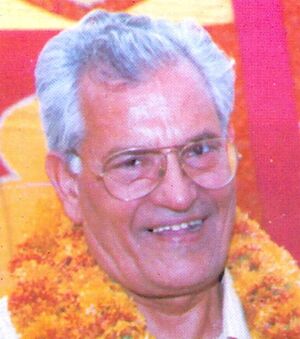Meel
| Author:Laxman Burdak, IFS (Retd.), Jaipur |
Meel (मील) [1] [2] (Meal,Mil) is gotra of Jats found in Rajasthan[3] and Haryana. Mil clan is found in Afghanistan.[4]
Origin
- The inhabitants of place called Mihran (मिहरान) were known as Meel. [5]
- Meel is derived from word Mir as l and r are interchangeable.
History
According to Dr Mahendra Singh Arya etc. the inhabitants of place called Mihran were known as Meel. [6] Mihran is also the name of Sindhu in Multan. They find mention with Mandas. The Mandas in the later period are found settled in Punjab and Sindh in sixth/seventh centuries AD. Ibn Haukal says that “the infidels who inhabited Sindh, are called Budha and Mand.” “The Mands dwell on the banks of Mihran (Sindhu) river. From the boundary of Multan to the sea… They form a large population. [7], [8]
Bhim Singh Dahiya's book "Aryan Tribes and the Rig Veda". mentions names of two seers Purumila (पुरुमील) and Ajamilah (आजमीळ्ह) showing its presence in Rigvedic times. (Rigveda:4/43-44). [9]
Sir H. M. Elliot[10] writes that the River Mihrán of Sind comes from well-known sources in the highlands of Sind, from the country belonging to Kanauj in the kingdom of Bauüra, and from Kashmír, Kandahár, and Táfan; and at length, running into Múltán, it receives the name of the Mihrán of gold, just as Múltán means boundary of gold.
Villages founded by Meel clan
- Bhagoo Mil Ka Bas (भागू मील का बास) - village in Laxmangarh tahsil in Sikar district of Rajasthan, was Founded by Bhagu Meel.
- Dhani Meelon Ki (ढाणी मीलों की)- village in tahsil and district Jhunjhunu in Rajasthan.
- Kolida (कोलिड़ा) - village in tahsil Laxmangarh of district Sikar in Rajasthan. Its ancient name, mentioned in Harsha Inscription 961 AD (L-38), was (कोलिकूप)/Kelikupaka (केलिकूपक)/ Kolikupaka (कोलिकूपक). It is main village of Meel gotra Jats. All Meel Jats have migrated from this village.
- Laxmangarh (लक्ष्मनगढ़) - town in Sikar district of Rajasthan in India was called Bergaon (बेड़गांव) in ancient times and was capital of Meel Jats.
- Meelon Ki Dhani Jhunjhunu (मीलों की ढाणी) - Village in tahsil Jhunjhunu, district Jhunjhunu, Rajasthan
- Meelon Ki Dhani Laxmangarh (मीलों की ढाणी) - Village in tahsil Laxmangarh, district Sikar, Rajasthan
- Meelon Ki Dhani Nawalgarh (मीलों की ढाणी) - Village in tahsil Nawalgarh, district Jhunjhunu, Rajasthan
- Milo Ka Bas (मिलो का बास) - village in Nawalgarh tehsil of Jhunjhunu district in Rajasthan.
- Malasar (मालासर) - village in Bikaner tehsil in Bikaner district of Rajasthan.
- Milon Ki Dhani (मीलों की ढाणी) - village in Sikar tehsil of Sikar district in Rajasthan.
- Meelyal (मीलयाल) is a village in Kupwara tahsil in Kupwara district of the Indian union territory of Jammu and Kashmir.
Kolida: The Capital of Meels
They are found mainly in Jaipur, Sikar, Jhunjhunu, Nagaur districts in Rajasthan. They are in Hisar, Sirsa and Fatehabad Districts of Haryana.
Maximum concentration of Meels is in Laxmangarh tahsil in Sikar district. Meel Jats had founded the village Bergaon, ancient name of Laxmangarh , where Rao Raja Laxman Singh of Sikar had built the Laxmangarh fort.[11] The ancient village Kolida in Sikar district is main village of Meel gotra Jats. All Meel Jats have migrated from this village. Kolida was the Capital of Meels. We get historical and inscriptional evidences of village Kolida.
Harsha Inscription of 961 AD of Chauhan dynasty mentions Kolira village.[12] The inscription tells us about genealogy of 6 princes of the same distinguished family whose head then held the neighbouring kingdom of Ajmer - the family of the Chauhan dynasty is continued from regularly from father to son starting from Guvaka and terminated in Sinharaja, in whose reign this work appears to have been commenced in AD 961.
The Harsha inscription tells us names of villages which were donated by nearby Chauhan rulers or chieftains from their controlled area to the temple of Shiva at Harsh. Koli Kupakā donated by Jaya-Sri-raja has been identified with Kolida. We reproduce relevant line from verse XLVIII (L-38) of this inscription:
- "Likewise, the young prince, the blessed Jaya-Sri-raja, religiously bestowed on Harsha-deva, the village of Koli-kūpaka, whose revenues were received by himself."[13]
In Chauhan History
The appearance of name Kolida in Harsha Inscription of year 961 about the Chauhan Dynasty indicates their association with Chauhans.
Dasharatha Sharma in book "Early Chauhan Dynasties" [P.171] while discussing Udayasimha Chauhan of Jalor writes that Iltutmish pushed on, and managed to reach Udayasimha's desert capital. ...Nearly five years later, perhaps in V. 1278 (1221 AD) when Iltutmish once again assumed the offensive against Rajasthan. Dasharatha Sharma (P.171,f.n.32) writes that the drama gives the name of the Muslim invader as Milachchhrikara (मीलच्छ्रिकार), which Dr. G.H. Ojha equates with Amir-i-shikar, a title once borne by Iltutmish. Drs.D.R. Barnett and H.C, Ray object to the identification, saying that Milachchhrikara cannot phonetically be the Sanskritised form of Amir-i-shikar. It is no doubt so; but it can be easily the Paisachi form of Mir-i-shikar. The Muslim ruler and his minister talk with each other in Paishachi; so it is only natural that he should have a Paisachi name. The dramatist changes Mir into Mila and shikar into chhrikara through the intermediate Sanskritised form Shrikara (Sikar?). The usual sandhi rules thereafter give us the Milachchhrikara, actually used in the drama. As regards the date of this expedition we put it about V. 1278 (1221 A.D.)
There can be two explanations of this name Milachchhrikara:
- we may consider that Milachchhrikara may be a combination of Mila (मील) + Chhikara (छिकार) = Milachchhrikara (मीलच्छ्रिकार), representing the combined forces of the two clans. Meel and Chhikara are two well known clans of Jats found in this area of Rajasthan and Haryana.
- Secondly In Sanskrit Milachchhrikara may be interpreted this way also:
- Mila + Shrikara = Milashshrikara. Milashshrikara might have changed to Milachchhrikara in prakrat language.
Shrikara (श्रीकर) is the sanskritized form of Sikar. Thus this sanskrit term means 'The Meels of Sikar'.
Meels in Jakhar History
We get some evidences about Meel clan from the history of Jakhar clan. Jakhars had a small republic state in Jangladesh area of Rajasthan. Bigga Ji Jakhar (1301 - 1336) rose to the status of a folk-deity of Jangladesh who was ruler of Riri. Riri is an old town in tahsil Dungargarh of the Bikaner district in Rajasthan. Biggaji was married to Meera daughter of Chaudhary Khidaji Meel of Malasar (Molaniya). Malasar village at present is in Bikaner tehsil, Bikaner district, Rajasthan. This shows the dominance of Meels in 12-13th century around Bikaner area.
In Afghan History
H. W. Bellew[14] writes that The eleventh satrapy of Darius, Herodotus says, comprised the Kaspioi, Pausikai, Pantimathoi, and Daritai.
H. W. Bellew[15] writes that has mentioned quoting Strabo as one of those Skythian tribes who deprived the Greeks of Baktriana. Speaking of the Skythians, Strabo says (Geog. xi. 8):
- " The best known tribes are those who deprived the Greeks of Baktriana, the Arioi, Pasianoi, Tokharoi and Sakarauloi, who came from the country beyond the Jaxartes, opposite the Sakai and Sogdianoi, and which country was also occupied by Sakai."
H. W. Bellew[16] writes that Out of these mentioned by Strabo, The Arienoi are also mentioned in the Bassarica of Denis of Samos along with the Kaspeiri and the Kossai (Kashuri and Khasa), who were the original people of Kasperia (Kashur, or Kashmir), as the same author observes. The Indian affinities of the clans are shown in view The list of their tribes includes many Indian tribes along with Mil.
Jat Gotras Namesake
Miletus was an ancient Greek city on the western coast of Anatolia, near the mouth of the Maeander River in ancient Ionia.[17][18][19] Its ruins are located near the modern village of Balat in Aydın Province, Turkey. The inhabitants of Miletus are called Milesians. Also called Miletos or Millawanda or Milawata.
Milyas was the mountainous country in the north of ancient Lycia, the south of Pisidia, and a portion of eastern Phrygia.[20]
Jat Gotras Namesake
- Meel = Milētus and Milesians (Anabasis by Arrian, p. 53-58, 149, 204, 275, 354, 385.)
- Meel = Milyas (Anabasis by Arrian, p. 67.)
Jat Gotras Namesake
- Meel = Miletus (Pliny.vi.39)
मील गोत्र की वंशावली
मील गोत्र की वंशावली में आदिपुरुष थेवाराम हुये। थेवाराम की सातवीं पीढ़ी में रात्मण मील हुये जिन्होने अजमेर से प्रस्थान कर रोहिली गाँव बसाया जिसको वर्तमान में नवलगढ़ कहते हैं। रात्मण मील के तीसरी पीढ़ी में पूनील मील हुये। पूनिल मील ने रोहिली से चलकर पालड़ी गाँव बसाया। पूनील मील के कई पीढ़ी बाद के वंशजों में गिरधारी मील हुये जिन्होने पालड़ी से चलकर गाँव कोलिड़ा बसे। (p.1)
गिरधारी मील के दो पुत्र हुये 1. केशाराम और 2. आशाराम। ये दोनों भाई कोलिड़ा से आकर संवत 1717 (= 1660 ई.) में भोजासर गाँव में आकर बस गए। (p.2)
रामेश्वरसिंह[21] के अनुसार भोजासर गांव के बसने की निश्चित तिथि असाढ़ बदी 1 संवत 1632 (=1575 ई.) बताई जाती है। इस गांव को बसाने वाला भोजा नाम का व्यक्ति था जो जाट जाति के मील गोत्र का था। उसके नाम पर इस गांव का नाम भोजासर पड़ा।
विक्रम संवत 1831 (1774 ई.) में सावन सुदी पंचमी के दिन लिखमा के बेटे नारायण चौधरी ने गांव भोजासर में जोहड़ (तालाब) बनाया। (p.6)
विक्रम संवत 1861 (1805 ई.) में फागण बदी सप्तमी के दिन हरजी के बेटे धानु और राजू ने गांव भोजासर में पक्की कोटडी कराई। (p.6)
गांव भोजासर में विक्रम संवत 1913 (1856 ई.) की साल कुशला चौधरी पर उसके बेटों (बनसा, लूणा, किशना, हुक्म, दुड़ा) ने छतरी 8 खम्भा की बनाई। (p.6)
साल विक्रम संवत 1928 (1872 ई.) में पौष बदी पूर्णिमा के दिन नारायण के पुत्र स्वरूपा ने गांव गोविंदपुरा बसाया जिसे बाद में आथूणा बास और अब संजयनगर कहते हैं। (p.6)
स्वतंत्रता सेनानी करणीराम मील (2.2.1914 - 13.5.1952) ने भोजासर गाँव को प्रसिद्धि दिलवाई। मील गोत्र की वंशावली में आदिपुरुष थेवाराम से करणीराम मील तक वंशावली निम्नानुसार है:
थेवाराम → लूणपसाव → हरू → कोलो → अलण → पालो (पालण) → पदमसी → रात्मण (रोहिली गाँव बसाया) → रतनसी → हाल्लू → पूनिल (पालड़ी गाँव बसाया) → (कई पीढ़ी बाद) → गिरधारी मील (पालड़ी से कोलिड़ा) → आशाराम मील (1660 ई. में भोजासर आकर बसे) → लिखमा → नारायण (1774 ई. में भोजासर में जोहड़ बनाया) → गंगा → सूखा → पुरो → परसो → देवा → करणीराम मील (2.2.1914 - 13.5.1952)
मील गोत्र की वंशावली में आदिपुरुष थेवाराम से रामेश्वरसिंह मील & डॉ. वीरेद्र सिंह तक वंशावली निम्नानुसार है:
थेवाराम → लूणपसाव → हरू → कोलो → अलण → पालो (पालण) → पदमसी → रात्मण (रोहिली गाँव बसाया) → रतनसी → हाल्लू → पूनिल (पालड़ी गाँव बसाया) → (कई पीढ़ी बाद) → गिरधारी मील (पालड़ी से कोलिड़ा) → आशाराम मील (1660 ई. में भोजासर आकर बसे) → लिखमा → हरजी → धन्ना (धानु) (1805 ई. में हरजी के बेटे धानु और राजू ने गांव भोजासर में पक्की कोटडी कराई) → कुशला (1856 ई. कुशला चौधरी पर उसके बेटों ने छतरी बनाई) → लूणाराम → हरदाराम → रूपाराम → रामेश्वर सिंह (IAS) (जन्म:31.7.1929) → डॉ. वीरेद्र सिंह (जन्म:09.09.1954)
स्रोत - डॉ. वीरेद्र सिंह
Distribution in Rajasthan
Locations in Jaipur city
Ambabari,Barkat Nagar,C-Scheme,Hanuman Nagar,Mansarowar Colony,Murlipura Scheme,Queens Road,Shastri Nagar,Sindhi Camp,Station Road,Vaishali Nagar,Vidyadhar Nagar,Watika (Sanganer),
Villages in Jaipur district
Villages in Sikar district
Ajeetpura Sikar (1), Aloda, Baijnath Ki Dhani, Balod Chhoti, Beri, Bhadhadar, Bhagu ka Bas (Rahnawa), Bibipur Chhota, Chachiwad Bara, Dadia, Dantru (2), Dedi Dhani (Ramgarh), Dhandhan (10), Dhani Hattidan Charan, Dhani Kharinta (Malikpur), Dudwa, Fatehpura, Godia Bada (20), Gothra (Tagalan) (3), Hamirpura, Hardayalpura, Harsawa Chhota, Kadma Ka Bas, Karanga Bara, Karejra, Katrathal, Khoru, Kolida, Lalasi, Laxmangarh, Mandela, Mailasi (40), Mandha Madani, Meel Ki Dhani, Miran, Mirjwas, Murlipura (Mandha), Nagardas, Netarwas, Poshani, Puran Badi, Raghunathpura Sikar (Khud), Sewa, Sheeshyoo, Sikar, Singhasan, Sonthaliya, Udaipura, Yalsar,
Villages in Churu district
Bheemsana, Chhabri Meethi, Karejra, Khyali, Malsar, Sardarshahar, Shyopura, Sardarshahar, Sujangarh (1), Taranagar, Thalori,
Villages in Sriganganagar district
Villages in Hanumangarh district
Villages in Jhunjhunu district
Bakra, Balariya, Bhojasar, Chindalia, Dundlod Mandi, Kaimari Ki Dhani, Ladusar, Dhani Meelon Ki, Udawas (40), Marigsar, Milo Ka Bas, Meelon Ki Dhani Jhunjhunu, Meelon Ki Dhani Nawalgarh, Swami Ki Dhani, Singnor,
Villages in Nagaur district
Villages in Alwar district
Distribution in Haryana
All of these came from Sikar District of Rajasthan some 300 Years back.
Villages in Fatehabad district
Dangra, Lahriyan, Shahidawali, Tibbi,
Villages in Bhiwani district
Villages in Hisar district
Dabra, Kharkari, Muklan, Saharwa, Kharia[22]
Villages in Sirsa district
Distribution in MP
Villages in Shivpuri district
Notable persons
- Dinesh Kumar Meel - Professor and Dean at Central University of Gujarat.
- Suresh Meel - Politician in Rajasthan.
- Mahendra Meel - Senior Nursing Officer, CHC Palsana.
- Karni Ram Meel - Leader of Shekhawati farmers movement
- Thana Ram Meel (चौधरी थानाराम मील), from Bhojasar , Jhunjhunu, was a leading Freedom fighter who took part in Shekhawati farmers movement in Rajasthan. [24]
- Raja Ram Meel - The modern Bhamasah of Jats & President, Rajasthan Jat Mahasabha
- Ruda Ram Meel from Palri Laxmangarh, Sikar, Rajasthan, was a leading Freedom Fighter who took part in Shekhawati farmers movement in Rajasthan.
- Surja Ram Meel - President Rajasthan Jat Samaj Sansthan (1999-2003)
- Dr. Banwari lal Meel- Principal specialist and Head of the Forensic Medicine Department at WSU, Mob.No.-0822007460
- Priyanka Meel - 1st Rank in Rajasthan Board of Secondary Examination - 2005, Appointed Scientist in ISRO
- Sanjiv Meel - IRS Rajasthan
- Dr Virendra Singh (Meel) (डॉ. वीरेद्र सिंह) - specialist in Respiratory diseases and Director of Asthma Bhawan Jaipur, Rajasthan.
- Jawahar Singh Meel - Social worker, Born on 21 March 1922 at village Mirajwas (मिरजवास) in Sikar district in Rajasthan.[25]
- Neki Ram Meel - Executive Engineer (NPCIL (DAE) ,Mumbai)
- D.C. Choudhary (Meel) - Rajasthan Accounts Service, Mobile Number: 9414055355
- Balbir Singh Meel - RAS (2009), Home District : Sikar
- Subhash Chand Meel - RAS-2012 from village Mordunga in Dhod tehsil of Sikar district in Rajasthan.
- Rameshwar Singh (Meel) - IAS (Retd) , Home District : Jhunjhunu
- Dr. Balbir Singh Meel - Major in AMC RMY , Date of Birth : 30-August-1978, village- Sonthaliya, Post- Baori, Tehsil- Srimadhopur, District- Sikar, pin-332411, Present Address : 31-A, Jay Residency ,Fatima nagar, Pune-411040, Phone:Mob: 9923628288, Email: balbir.meel@gmail.com
- Dr.K.C. Meal - Govt. Service, Medical Officer MCD. 50, Anamika Apptts., IP Extn., New Delhi 011-22441727. NCR (PP-617)
- Gangajal Meel - विधायक सुरतगढ़, 45, नई धान मण्डी, हनुमानगढ़ टाउन, Mob:9829855555, 9414095321, Elected Cong.M.L.A.from Suratgarh, Sriganganagar(Raj.) in 2009
- पृथ्वीराज मील - पूर्व जिला प्रमुख श्रीगंगानगर
- विद्याधर मील - सरपंच दांतरु Dantru, प्रदेश उपाध्यक्ष NSUI
- Avinash Meel - RAS (2012), (Rank-210) from Hetamsar (Sikar)
- Akhilesh Meel: Indian Foreign Service – 2011, IRAN posted +989128109102
- Narendra Meel, Deputy Commandant, Border Security Force (BSF), Mob: 93403 90110
- Keshardeo Meel (Sepoy) (15.11.1944 - 10.12.1971) became martyr on 10.12.1971 in Chhamb-Joria sector of Jammu and Kashmir during Indo-Pak War-1971. He was from ancient village Kolida in Sikar tahsil of Sikar district in Rajasthan.
- Unit: 9 Jat Regiment.
Gallery of Meel people
Statue of Karni Ram Meel with Ramdev Singh Gill at Jhunjhunu
Surja Ram Meel, President Rajasthan Jat Samaj Sansthan (1999-2003)
Professor Banwari Lal Meel
References
- ↑ Jat History Dalip Singh Ahlawat/Parishisht-I, s.n. म-51
- ↑ O.S.Tugania:Jat Samuday ke Pramukh Adhar Bindu,p.56,s.n. 2069
- ↑ Jat History Thakur Deshraj/Chapter IX,s.n. 86,p-695
- ↑ An Inquiry Into the Ethnography of Afghanistan, H. W. Bellew, p.145
- ↑ Mahendra Singh Arya et al: Adhunik Jat Itihas, p. 274
- ↑ Mahendra Singh Arya et al: Adhunik Jat Itihas, p. 274
- ↑ Elliot and Dowson, op. cit., Vol. I, p. 38
- ↑ Bhim Singh Dahiya, Jats the Ancient Rulers, p. 136
- ↑ नरो यद वाम अश्विना सतोमम आवन सधस्तुतिम आजमीळ्हासो अग्मन Rigveda 4-44
- ↑ The History of India, as Told by Its Own Historians/III. Al Mas'údí,p.21
- ↑ Mansukh Ranwa:Amar Shaheed Lothoo Jat, 2000, p. 12
- ↑ Sikar Ki Kahani, Captain Webb Ki Jubani, 2009, p. 79
- ↑ L-38:[*तथा युवरा]ज: श्रीजयश्रीराज स्वभुज्यमानकोलिकूपग्रामं भक्तया हर्षदेवाय शासनेन दत्तवान् ।
- ↑ An Inquiry Into the Ethnography of Afghanistan, p.140
- ↑ An Inquiry Into the Ethnography of Afghanistan, p.142
- ↑ An Inquiry Into the Ethnography of Afghanistan, p.144
- ↑ Sharon R. Steadman; Gregory McMahon; John Gregory McMahon (15 September 2011). The Oxford Handbook of Ancient Anatolia: (10,000-323 BCE). Oxford University Press. p. 369 and 608. ISBN 978-0-19-537614-2.
- ↑ Luc-Normand Tellier, Urban World History: An Economic and Geographical Perspective, p. 79:
- ↑ Carlos Ramirez-Faria (1 January 2007). Concise Encyclopeida Of World History. Atlantic Publishers & Dist. pp. 305–. ISBN 978-81-269-0775-5.
- ↑ Strabo. xii. p. 573.
- ↑ Rameshwar Singh Meel:Shekhawati Ke Gandhi Amar Shahid Karni Ram/Janm, Shaishav Aur Shiksha,pp.1-2
- ↑ User:Mitta
- ↑ User:Saharan88
- ↑ Thakur Deshraj:Jat Jan Sewak, 1949, p.407-408
- ↑ Mahendra Singh Arya et al: Adhunik Jat Itihas, p. 355
Back to Gotras
- Jat Gotras
- Gotras after Places
- Rajasthan
- Haryana
- Madhya Pradesh
- Gotras in Sikar
- Gotras in Churu
- Gotras in Nagaur
- Gotras in Jhunjhunu
- Gotras in Jaipur
- Gotras in Ganganagar
- Gotras in Hanumangarh
- Gotras in Alwar
- Gotras in Bhiwani
- Gotras in Hisar
- Gotras in Sirsa
- Gotras in Fatehabad
- Gotras in Shivpuri
- Jat Gotras in Afghanistan
- Genealogy
- Bard History





















